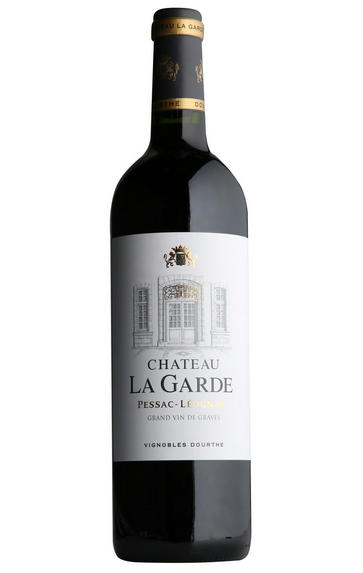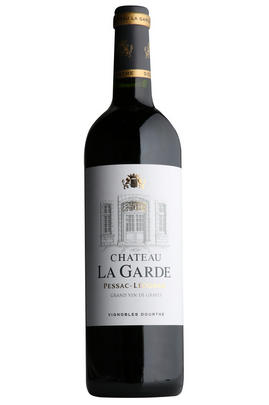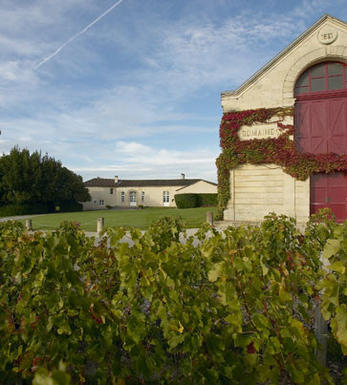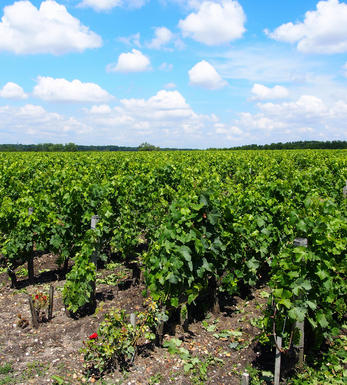
2022 Château la Garde, Pessac-Léognan, Bordeaux

Critics reviews
Jane Anson, janeanson.com (May 2023)
The 2022 La Garde has an elegant and fresh bouquet with aromas of cassis, blueberry, raspberry, spices and violet. Medium to full-bodied, the palate is round and seamless with velvety tannins, a concentrated texture and a long and penetrating finish with hints of oak and a firm, tannic sensation. It's a blend of 63% Merlot and 37% Cabernet Sauvignon.
Yohan Castaing, Wine Advocate (April 2023)
About this WINE

Chateau la Garde
Château La Garde is a rising star of the Pessac-Léognan wine appellation owned by the dynamic Bordeaux negociant company Dourthe-Kressman. It is a medium-sized property with 47 hectares of vineyards in, planted with Cabernet Sauvignon, Merlot and Sauvignon Blanc.
The Cabernet-dominated red wines are soft, well structured and packed with smooth, ripe fruit which makes them very attractive young, though they also possess good medium-term cellaring potential. The red wines display the true Graves minerality underneath an exuberant cassis-and-plums aroma.
Albeit predominantly a red wine vineyard, it does have at its heart a small patch of land which is more suited to the production of white wine, from which a mere 1,000 cases of exquisitely-scented, vibrant white Bordeaux is produced each year.
What is unique to La Garde is the presence in the vineyard of a parcel of rare Sauvignon Gris, a close cousin of the Sauvignon Blanc but a varietal which yields a slightly richer, rounder character to the finished blend. 50% of the wine comes from this grape and the touch of complexity it imparts lifts this wine above most of its competitors.
The investment made by Dourthe in both vineyard and cellar is now beginning to bear fruit, both figuratively and literally, in the form of exceptional wines of both colours, and any re-assessment of the Pessac-Léognan classification would surely see La Garde feature amongst the Classified Growths.

Pessac-Leognan
In 1986 a new communal district was created within Graves, in Bordeaux, based on the districts of Pessac and Léognan, the first of which lies within the suburbs of the city. Essentially this came about through pressure from Pessac-Léognan vignerons, who wished to disassociate themselves from growers with predominately sandy soils further south in Graves.
Pessac-Léognan has the best soils of the region, very similar to those of the Médoc, although the depth of gravel is more variable, and contains all the classed growths of the region. Some of its great names, including Ch. Haut-Brion, even sit serenely and resolutely in Bordeaux's southern urban sprawl.
The climate is milder than to the north of the city and the harvest can occur up to two weeks earlier. This gives the best wines a heady, rich and almost savoury character, laced with notes of tobacco, spice and leather. Further south, the soil is sandier with more clay, and the wines are lighter, fruity and suitable for earlier drinking.
Recommended Châteaux: Ch. Haut-Brion, Ch. la Mission Haut-Brion, Ch. Pape Clément, Ch Haut-Bailly, Domaine de Chevalier, Ch. Larrivet-Haut-Brion, Ch. Carmes Haut-Brion, Ch. La Garde, Villa Bel-Air.

Merlot/Cabernet Franc
Merlot and Cabernet Franc are grape varieties commonly used in Bordeaux-style blends, particularly in the Bordeaux region of France. When these two grapes are blended, they can create a wine that combines the best characteristics of each variety.
Merlot is known for its smoothness, soft tannins, and ripe fruit flavours. It often contributes black cherry, plum, and chocolate flavours to the blend. The grapes are relatively easy to grow and ripen earlier than other Bordeaux varieties, making them versatile for blending.
Cabernet Franc, on the other hand, adds structure, depth, and complexity to the blend. It typically brings aromas of red fruits such as raspberry and strawberry, along with herbal notes like bell pepper and tobacco. These grapes have thinner skins and can be more challenging to cultivate, requiring specific growing conditions to reach their full potential.
When Merlot and Cabernet Franc are combined, the result is a well-balanced wine with various flavours and aromas. The blend often exhibits a Bordeaux wine's medium to full body, along with a smooth texture and moderate tannins. The specific flavour profile can vary depending on the proportions of each grape in the blend and the terroir and winemaking techniques employed.


Buying options
Add to wishlist
Description
Although not a Classified Growth, La Garde always carries much of the same finesse as more famous names while being ready to drink a bit earlier. The 2022 is very well balanced, with appealing graphite and tobacco notes. It will deliver immediate pleasure, enhanced by just a few years in the bottle.
There’s a new winery here since 2021 and Axel Marchal now consults. Emphasis has been put on what winemaker Frédéric Bonnafous describes as trying to “tame” the assertive gravel and clay terroir here. There is now less grand vin made, down to 40% of production.
Drink 2026 - 2035
Score: 16/20
Berry Bros. & Rudd (April 2023)
wine at a glance
Delivery and quality guarantee